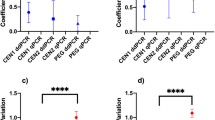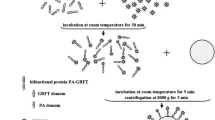Abstract
Environmental surveillance of porcine reproductive and respiratory syndrome virus (PRRSV) represents a key issue in control of the disease. CD151 has recently been recognized as one of several receptors for PRRSV. We describe here a novel method for concentration of PRRSV from the environmental samples by CD151-binding capture. After fusion to self-aggregating peptide ELK16, the large extracellular loop (LEL) of porcine CD151 and its two segments (namely N63 and C63) were expressed in E. coli as protein aggregates. The three fusion proteins were purified to high purities by regular centrifugation and washing with Triton X-100. Viral binding assay showed that the C63-ELK16 protein, but not ELK16-N63 protein, had the specific binding affinity for PRRSV. The C63-ELK16 protein could bind to, and eluted from, PRRSV in pH-, temperature-, and time-dependent manners with a final virus recovery of 44.7%. By using PRRSV-spiked and experimentally infected pig fecal slurry samples, the C63-ELK16 binding capture-combined quantitative RT-PCR was shown to have higher detection sensitivity than the conventional RT-PCR. Although the viral RNA could be detected in the experimentally infected pig samples with or without C63-ELK16 binding capture, infectious PRRSV was not isolated without C63-ELK16 binding capture. Therefore, the CD151-binding capture method established offers sufficient recovery and quickness and will facilitate environmental PRRSV surveillance.








Similar content being viewed by others
References
Cannon JL, Vinje J (2008) Histo-blood group antigen assay for detecting noroviruses in water. Appl Environ Microbiol 74:6818–6819
Cavanagh D (1997) Nidoviales: a new order comprising Cornaviridae and Arteriviridae. Arch Virol 142:629–633
Collins JE, Benfield DA, Christianson WT, Harris L, Hennings JC, Shaw DP, Goyal SM, McCullough S, Morrison RB, Joo HS, Gorcyca D, Chladek D (1992) Isolation of swine infertility and respiratory syndrome virus (isolate ATCC VR 2332) in North America and experimental reproduction of the disease in gnotobiotic pigs. J Vet Diagn Investig 4:117–126
Cutler T, Wang C, Qin Q, Zhou F, Warren K, Yoon K, Hoff S, Ridpath J, Zimmerman J (2011) Kinetics of UV(254) inactivation of selected viral pathogens in a static system. J Appl Microbiol 111:389–395
Giammarioli M, Pellegrini C, Casciari C, De Mia GM (2008) Development of a novel hot-start multiplex PCR for simultaneous detection of classical swine fever virus, African swine fever virus, porcine circovirus type 2, porcine reproductive and respiratory syndrome virus and porcine parvovirus. Vet Res Commun 32(3):255–262
Gregory JB, Webster LF, Griffith JF, Stewart JR (2011) Improved detection and quantification of norovirus from water. J Virol Methods 172:38–45
Li GY, Xiao ZZ, Lu HP, Li YY, Zhou XH, Tan X, Zhang XY, Xia XL, Sun HC (2016) A simple method for recombinant protein purification using self-assembling peptide-tagged tobacco etch virus protease. Protein Expr Purif 128:86–92
Lunney JK, Steibel JP, Reecy JM, Fritz E, Rothschild MF, Kerrigan M, Trible B, Rowland RR (2011) Probing genetic control of swine responses to PRRSV infection: current progress of the PRRS host genetics consortium. BMC Proc 5(Suppl 4):S30
Morton V, Jean J, Farber J, Mattison K (2009) Detection of noroviruses in ready-to-eat foods by using carbohydrate-coated magnetic beads. Appl Environ Microbiol 75:4641–4643
Nieuwenhuis N, Duinhof TF, van Nes A (2012) Economic analysis of outbreaks of porcine reproductive and respiratory syndrome virus in nine sow herds. Vet Rec 170:225
Pan L, Zhang Q, Li X, Tian P (2012) Detection of human norovirus in cherry tomatoes, blueberries and vegetable salad by using a receptor-binding capture and magnetic sequestration (RBCMS) method. Food Microbiol 30(2):420–426
Pileri E, Mateu E (2016) Review on the transmission of porcine reproductive and respiratory syndrome virus between pigs and farms and impact on vaccination. Vet Res 47(1):108
Rowland RR, Morrison RB (2012) Challenges and opportunities for the control and elimination of porcine reproductive and respiratory syndrome virus. Transbound Emerg Dis 59(Suppl 1):55–59
Shanmukhappa K, Kim JK, Kapil S (2007) Role of CD151, a tetraspanin, in porcine reproductive and respiratory syndrome virus infection. Virol J 4:62
Sincock PM, Fitter S, Parton RG, Berndt MC, Gamble JR, Ashman LK (1999) PETA-3/CD151, a member of the transmembrane 4 superfamily, is localised to the plasma membrane and endocytic system of endothelial cells, associates with multiple integrins and modulates cell function. J Cell Sci 112(Pt 6):833–844
Tian K, Yu X, Zhao T, Feng Y, Cao Z, Wang C, Hu Y, Chen X, Hu D, Tian X, Liu D, Zhang S, Deng X, Ding Y, Yang L, Zhang Y, Xiao H, Qiao M, Wang B, Hou L, Wang X, Yang X, Kang L, Sun M, Jin P, Wang S, Kitamura Y, Yan J, Gao GF (2007) Emergence of fatal PRRSV variants: unparalleled outbreaks of atypical PRRS in China and molecular dissection of the unique hallmark. PLoS One 2(6):e526
Tian P, Yang D, Pan L, Mandrell R (2012) Application of a receptor-binding capture quantitative reverse transcription-PCR assay to concentrate human norovirus from sewage and to study the distribution and stability of the virus. Appl Environ Microbiol 78(2):429–436
Wang X, Zhou B, Hu W, Zhao Q, Lin Z (2015) Formation of active inclusion bodies induced by hidrophobic self-assembling peptide GFIL8. Microb Cell Factories 14:88
Wills RW, Zimmerman JJ, Yoon KJ, Swenson SL, McGinley MJ, Hill HT, Platt KB, Christopher-Hennings J, Nelson EA (1997a) Porcine reproductive and respiratory syndrome virus: a persistent infection. Vet Microbiol 55(1–4):231–240
Wills RW, Zimmerman JJ, Yoon KJ, Swenson SL, Hoffman LJ, McGinley MJ, Hill HT, Platt KB (1997b) Porcine reproductive and respiratory syndrome virus: routes of excretion. Vet Microbiol 57(1):69–81
Wu W, Xing L, Zhou B, Lin Z (2011) Active protein aggregates induced by terminally attached self-assembling peptide ELK16 in Escherichia coli. Microb Cell Factories 10:9
Yue F, Cui S, Zhang C, Yoon KJ (2009) A multiplex PCR for rapid and simultaneous detection of porcine circovirus type 2, porcine parvovirus, porcine pseudorabies virus, and porcine reproductive and respiratory syndrome virus in clinical specimens. Virus Genes 38(3):392–397
Zhang Q, Yoo D (2015) PRRS virus receptors and their role for pathogenesis. Vet Microbiol 177(3–4):229–241
Zhang Z, Chen J, Shi H, Chen X, Shi D, Feng L, Yang B (2012a) Identification of a conserved linear B-cell epitope in the M protein of porcine epidemic diarrhea virus. Virol J 9:225
Zhang Y, Sun HC, Huang YY, Zhang XY, Xia XL (2012b) Expression and recombinant porcine CD151 and inhibitory effect of the antiserum on PRRSV infection. J Yangzhou University 33(2):1–5 (In Chinese)
Zhu L, Bao L, Zhang X, Xia X, Sun H (2015) Inhibition of porcine reproductive and respiratory syndrome virus replication with exosome-transferred artificial microRNA targeting the 3'untranslated region. J Virol Methods 223:61–68
Acknowledgements
The authors wish to thank Jiangsu Key Laboratory for High-Tech Research and Development of Veterinary Biopharmaceuticals, Jiangsu Agri-animal Husbandry Vocational College for providing the animal facility and technical assistance.
Funding
This work was supported by Priority Academic Program Development of Jiangsu Higher Education Institutions (PAPD), and Special Prospective Research Project of Jiangsu Province, China (BE2004380).
Author information
Authors and Affiliations
Corresponding author
Ethics declarations
Conflict of interest
The authors declare that they have no conflicts of interest.
Ethical statement
The animal experiment was performed by following the animal ethics guidelines and approved protocols by Jiangsu Agri-Animal Husbandry Vocational College.
Rights and permissions
About this article
Cite this article
Zong, Y., Zong, X., Xia, W. et al. A novel method for concentration of porcine reproductive and respiratory syndrome virus from the environmental samples using self-aggregating peptide-tagged CD151-binding capture. Appl Microbiol Biotechnol 101, 7987–7996 (2017). https://doi.org/10.1007/s00253-017-8477-0
Received:
Accepted:
Published:
Issue Date:
DOI: https://doi.org/10.1007/s00253-017-8477-0




